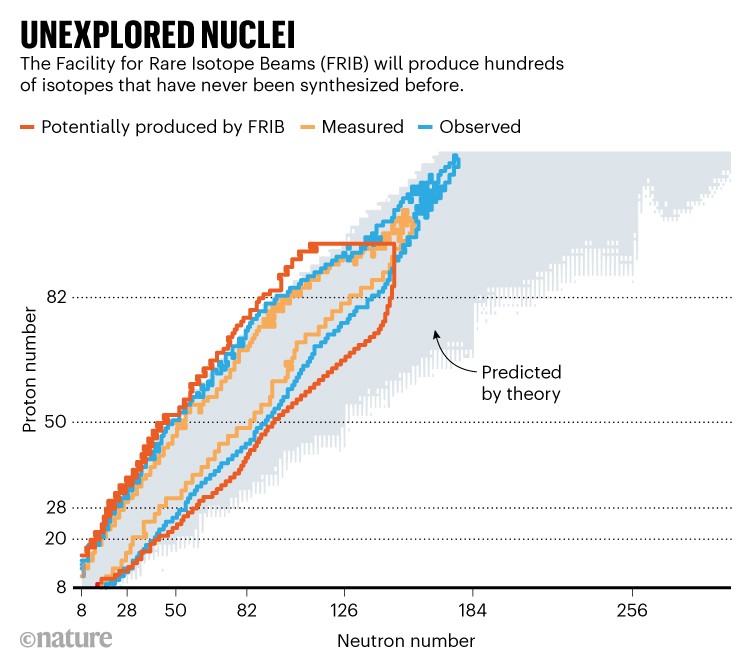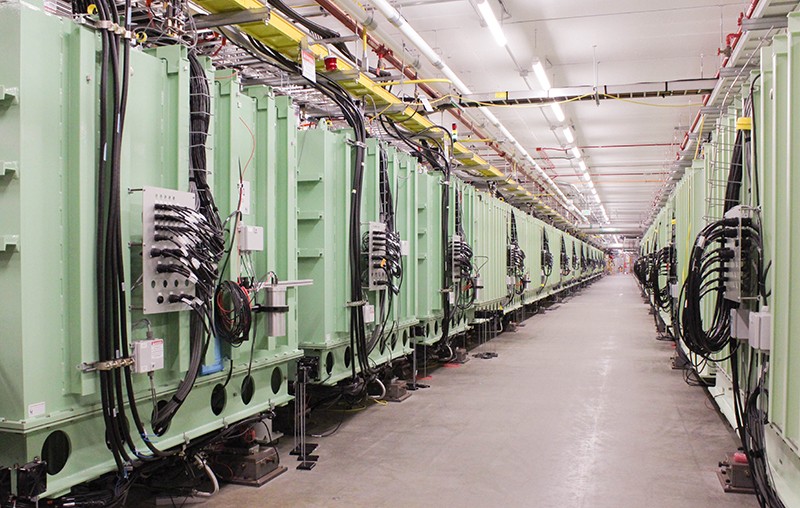One of nuclear physicists’ top wishes is about to come true. After a decades-long wait, a US$942 million accelerator in Michigan is officially inaugurating on 2 May. Its experiments will chart unexplored regions of the landscape of exotic atomic nuclei and shed light on how stars and supernova explosions create most of the elements in the Universe.
“This project has been the realization of a dream of the whole community in nuclear physics,” says Ani Aprahamian, an experimental nuclear physicist at the University of Notre Dame in Indiana. Kate Jones, who studies nuclear physics at the University of Tennessee in Knoxville, agrees. “This is the long-awaited facility for us,” she says.
The Facility for Rare Isotope Beams (FRIB) at Michigan State University (MSU) in East Lansing had a budget of $730 million, most of it funded by the US Department of Energy, with a $94.5 million contribution from the state of Michigan. MSU contributed an additional $212 million in various ways, including the land. It replaces an earlier National Science Foundation accelerator, called the National Superconducting Cyclotron Laboratory (NSCL), at the same site. Construction of FRIB started in 2014 and was completed late last year, “five months early and on budget”, says nuclear physicist Bradley Sherrill, who is FRIB’s science director.
For decades, nuclear physicists had been pushing for a facility of its power — one that could produce rare isotopes orders of magnitude faster than is possible with the NSCL and similar accelerators worldwide. The first proposals for such a machine came in the late 1980s, and consensus was reached in the 1990s. “The community was adamant that we need to get a tool like this,” says Witold Nazarewicz, a theoretical nuclear physicist and FRIB’s chief scientist.
Inner workings
All FRIB experiments will start in the facility’s basement. Atoms of a specific element, typically uranium, will be ionized and sent into a 450-metre-long accelerator that bends like a paper clip to fit inside the 150-metre-long hall. At the end of the pipe, the beam of ions will hit a graphite wheel that spins continuously to avoid overheating any particular spot. Most of the nuclei will pass through the graphite, but a fraction will collide with its carbon nuclei. This causes the uranium nuclei to break up into smaller combinations of protons and neutrons, each a nucleus of a different element and isotope.
This beam of assorted nuclei will then be directed up to a ‘fragment separator’ at ground level. The separator consists of a series of magnets that deflect each nucleus towards the right, each at an angle that depends on its mass and charge. By fine-tuning this process, the FRIB operators will be able to produce a beam consisting entirely of one isotope for each particular experiment.
The desired isotope can then be routed through a maze of beam pipes to one of many experimental halls. In the case of the rarest isotopes, production rates could be as low as one nucleus a week, but the lab will be able to deliver and study nearly every single one, Sherrill says.
A unique feature of FRIB is that it has a second accelerator that can take the rare isotopes and smash them against a fixed target, to mimic the high-energy collisions that happen inside stars or supernovae.
FRIB will start operating with a relatively low beam intensity, but its accelerator will gradually ramp up to produce ions at a rate that is orders of magnitude higher than NSCL’s. Each uranium ion will also travel faster to the graphite target, carrying an energy of 200 mega-electronvolts, compared with the 140 MeV carried by ions in the NSCL. FRIB’s higher energy is in the ideal range for producing a vast number of different isotopes, says Sherrill, including hundreds that have never been synthesized before.
The edge of knowledge
Physicists are excited by FRIB coming online, because their knowledge of the landscape of isotopes is still tentative. The forces that hold atomic nuclei together are, in principle, the result of the strong force — one the four fundamental forces of nature, and the same force that binds three quarks together to make a neutron or a proton. But nuclei are complex objects with many moving parts, and it is impossible to predict their structures and properties exactly from first principles, says Nazarewicz.
Researchers have therefore concocted a variety of simplified models that predict some features of a certain range of nuclei, but might fail or give only approximate estimates outside that range. This applies even to basic questions, such as how fast an isotope decays — its half-life — or whether it can form at all, says Nazarewicz. “If you ask me how many tin isotopes exist, or lead, the answer will be given with a large error bar,” he says. FRIB will be able to synthesize hundreds of previously unobserved isotopes (see ‘Unexplored nuclei’), and by measuring their properties, it will begin to put many nuclear models to the test.
Jones and others will be especially keen to study isotopes that have ‘magic’ numbers of protons and neutrons — such as 2, 8, 20, 28 or 50 — that make the structure of the nucleus especially stable because they form complete energy levels (known as shells). Magic isotopes are particularly important because they provide the cleanest tests for the theoretical models. For many years, Jones and her group have studied tin isotopes with progressively fewer neutrons, edging towards tin-100, which has magic numbers of both neutrons and protons.
Theoretical uncertainties also mean that researchers do not yet have a detailed explanation for how all the elements in the periodic table formed. The Big Bang produced essentially only hydrogen and helium; the other chemical elements in the table up to iron and nickel formed mostly through nuclear fusion inside stars. But heavier elements cannot form by fusion. They were forged by other means — typically through radioactive β-decay. This happens when a nucleus gains so many neutrons that it becomes unstable, and one or more of its neutrons turns into a proton, creating an element with a higher atomic number.
This can happen when nuclei are bombarded with neutrons in brief but cataclysmic events, such as a supernova or the merger of two neutron stars. The most well-studied event of that type, which was observed in 2017, was consistent with models in which the colliding orbs produce elements heavier than iron. But astrophysicists could not observe which specific elements were made, or in what quantities, says Hendrik Schatz, a nuclear astrophysicist at MSU. One of FRIB’s main strengths will be to explore the neutron-rich isotopes that are made during these events, he says.
The facility will help to answer the fundamental question of “how many neutrons can one add to a nucleus, and how does it change the interactions inside the nucleus?” says Anu Kankainen, an experimental physicist at the University of Jyväskylä in Finland.
FRIB will be complementary to other state-of-the-art accelerators that study nuclear isotopes, says Klaus Blaum, a physicist at the Max Planck Institute for Nuclear Physics in Heidelberg, Germany. Facilities in Japan and Russia are optimized to produce the heaviest possible elements, those at the end of the periodic table.
The €3.1 billion Facility for Antiproton and Ion Research (FAIR), an atom smasher that is under construction in Darmstadt, Germany, is scheduled to be completed in 2027 (although the freezing of Russia’s participation following the invasion of Ukraine could bring some delays). FAIR will produce antimatter as well as matter, and will be able to store nuclei for longer periods of time. “You cannot do everything with a single machine,” says Blaum, who has been on advisory committees for both FRIB and FAIR.

